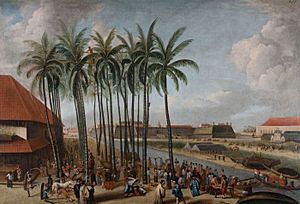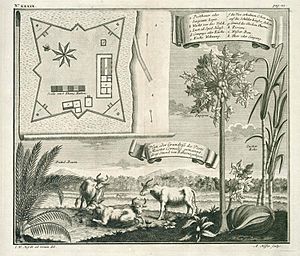Invasion of Java (1811) facts for kids
Quick facts for kids Invasion of Java |
|||||||||
|---|---|---|---|---|---|---|---|---|---|
| Part of the Napoleonic Wars | |||||||||
 British Army landing at Cilincing, Java. |
|||||||||
|
|||||||||
| Belligerents | |||||||||
| Commanders and leaders | |||||||||
|
Jan Willem Janssens | ||||||||
| Strength | |||||||||
| Unknown | |||||||||
| Casualties and losses | |||||||||
| 1,000 | 2,000 | ||||||||
The Invasion of Java in 1811 was a successful military operation by the British against the island of Java. This happened between August and September 1811 during the Napoleonic Wars. Java was a colony of the Dutch Republic. However, during the French Revolutionary and Napoleonic Wars, France took control of the Netherlands. This meant Java became a French colony, even though Dutch officials still managed it.
After the British captured French colonies in other parts of the world, they turned their attention to the Dutch East Indies. An expedition was sent from India in April 1811. British troops landed on Java on August 4. By August 8, the city of Batavia surrendered without a fight. The Dutch and French defenders moved to a strong fort called Fort Cornelis. The British surrounded this fort and captured it on August 26. The remaining defenders were chased, and the city of Salatiga surrendered on September 16. The entire island officially surrendered to the British on September 18.
Java stayed under British control for the rest of the Napoleonic Wars. But it was given back to the Dutch in 1814.
Contents
Why the British Invaded Java
For several years, France controlled the Netherlands, which was already at war with Britain. In 1807, Herman Willem Daendels was made Governor General of the Dutch East Indies. He arrived in Java in 1808 and started building up the island's defenses. He created a strong camp called Fort Cornelis, located south of Batavia. He also built new hospitals, army barracks, and weapons factories.
In 1810, France officially took over the Netherlands. Napoleon Bonaparte himself chose Jan Willem Janssens to replace Daendels. Janssens had been defeated by the British before, at the Battle of Blaauwberg in 1806. He arrived in Java in April 1811 with some French ships and soldiers.
The British had already captured other Dutch islands in the East Indies, like Ambon and the Molucca Islands. They had also recently taken French islands like Réunion and Mauritius. Stamford Raffles, a British official, suggested to Lord Minto, the Governor-General of India, that Java should also be captured. Lord Minto liked the idea and decided to lead the expedition himself.
The British Navy was active around Java even before the main invasion. On May 23, 1811, a group from HMS Sir Francis Drake attacked Dutch gunboats near Surabaya, capturing nine of them. On July 30, British ships attacked Merak in northwestern Java, destroying its fort. On the same day, HMS Procris attacked six Dutch gunboats, capturing five and destroying one.
The Invasion Begins
The British forces gathered in India in early 1811. The first group of soldiers left Madras on April 18. The second group left Calcutta on April 21. All the forces met at Malacca by June 1. Lieutenant-General Sir Samuel Auchmuty became the overall military commander. Commodore William Robert Broughton led the naval forces.
The British force had about 12,000 soldiers, though some were sick. They sailed towards Java and arrived near Indramayu on June 30. On July 31, a British ship, the Procris, found a group of Dutch boats. British sailors attacked and captured five of the six French gunboats protecting the convoy.
The British waited for information about the Dutch defenses. An officer suggested landing at Cilincing, a fishing village east of Batavia. On August 4, the British fleet anchored and began landing troops. The defenders were surprised. About 8,000 British soldiers landed before the Franco-Dutch troops arrived. After a short fight, the Franco-Dutch forces retreated.
Batavia Falls to the British
When General Janssens heard about the British landing, he left Batavia with his army. His army had between 8,000 and 10,000 men. They went to Fort Cornelis to defend it. The British marched into Batavia on August 8 and found it empty. The city surrendered to the British.
The British were disappointed because parts of the city had been set on fire. Many warehouses full of coffee and sugar were looted or flooded. This meant the British couldn't get the valuable goods. On August 9, Rear-Admiral Robert Stopford arrived and took over from Commodore Broughton, who was thought to be too careful.
British Push Forward
General Janssens had hoped that the tropical climate and diseases would weaken the British army. But the British kept moving towards Janssens's main fort. The Dutch military base at Weltevreeden fell to the British on August 10. The British lost fewer than 100 men, while the defenders lost over 300. In one fight, a French general working for Janssens was killed. He mistook British soldiers in green uniforms for Dutch troops.
Weltevreeden was about six miles from Fort Cornelis. On August 20, the British started building their own defenses about 600 yards from the Franco-Dutch positions.
The Battle for Fort Cornelis
Fort Cornelis was a large fort, about one mile long and 600 to 800 yards wide. It had 280 cannons on its walls. The defenders were a mix of Dutch, French, and local East Indies soldiers. Many of the local troops were not very loyal or effective. However, some artillerymen from Celebes fought bravely.
The captured Weltevreeden base was perfect for the British to attack Fort Cornelis. On August 14, the British finished a path through the forests. This allowed them to bring up heavy cannons and supplies. They started attacking the north side of the fort. For several days, the fort and British cannons exchanged fire.
Early on August 22, soldiers from the fort attacked. They briefly took control of three British cannon positions. But they were pushed back by British and Indian soldiers. The fighting continued with heavy fire. On August 24, a deserter helped General Rollo Gillespie capture two of the fort's smaller forts by surprise. Gillespie, who was sick with fever, still managed to storm a third fort. A French general was captured. Two Dutch officers blew up a gunpowder storage area, sacrificing themselves.
These three smaller forts were key to the defense. Losing them made most of Janssens's East Indian troops lose hope. Many Dutch soldiers also left, no longer supporting the French. The British stormed the main fort at midnight on August 25. They captured it after a tough fight. The siege cost the British 630 casualties. The defenders had many more casualties. About 5,000 men were captured, including many officers. One thousand men were found dead in the fort. Janssens escaped to Buitenzorg with a few remaining soldiers. But he had to leave that town when the British arrived.
By August 27, the British had lost 141 soldiers killed, 733 wounded, and 13 missing from the army. The navy lost 15 killed, 45 wounded, and three missing.
Later Fights and Surrender
British Navy ships continued to patrol the coast. On September 4, two French ships tried to escape from Surabaya. British ships chased them, but the French ships managed to get away and return to Europe.
On August 31, British forces captured the fort and town of Sumenep on Madura Island. The rest of Madura and nearby islands soon joined the British side. Thinking Janssens was in Cirebon, British forces landed there on September 4. The defenders quickly surrendered. A French general from Janssens's staff was captured. The town and fort of Taggal surrendered on September 12 after British ships arrived.
While the navy took control of coastal towns, the army moved into the island's interior. Janssens received help on September 3 from 1,200 horsemen and other local fighters. On September 16, Salatiga fell to the British. Janssens attacked a British force that day but was pushed back. Many local fighters killed their Dutch officers during the retreat. With very few men left, Janssens surrendered two days later, on September 18.
After the Invasion
The British had already captured other Dutch islands in 1810. Java was the last major Dutch colony in the East not under British control. Its capture meant the war in these waters was mostly over. Stamford Raffles was made the new governor of Java. He changed how the island was run, making land ownership fairer and increasing trade.
Britain gave Java and other East Indian islands back to the Netherlands in 1814. One lasting change from the British rule was the road rules. The British made traffic drive on the left side of the road. This rule is still followed in Indonesia today.
Sepoy Cultural Connection
In 1815, some Bengali soldiers, called sepoys, were stationed in Yogyakarta. They were very interested in the Hindu traditions of the local court and the old Javanese temples like Prambanan and Borobodur. They felt a strong connection to these ancient Hindu sites.
The soldiers felt that Java was a special place for their gods. They believed it was the "land of Brama" mentioned in their holy books. They thought it was wrong that this land was controlled by Europeans. They even planned to change the leadership and have a Bengali administration on the island.
The local ruler, Sunan of Surakarta, was very interested in the Hindu sepoys. He would attend their religious ceremonies and even provided Hindu statues for their worship. He welcomed the sepoy leaders to his court. They would talk about India and show off their skills. The sepoys told him that the British power depended on their Indian troops. This cultural connection and shared religious interest led to the idea of a new leadership for Java.
British Military Forces
When Rear-Admiral Stopford arrived on August 9, his fleet included many ships. There were large warships like the HMS Scipion and HMS Illustrious, each with 74 cannons. There were also many smaller frigates and sloops. In total, the Royal Navy had about 25 warships.
The British Army also had a large force. This included about 12,000 soldiers. Many of these soldiers were from India, including Bengali and Madrasi troops. The Navy also provided Royal Marines. General Samuel Auchmuty was the main commander, but Major General Rollo Gillespie led the troops in the field.
|




